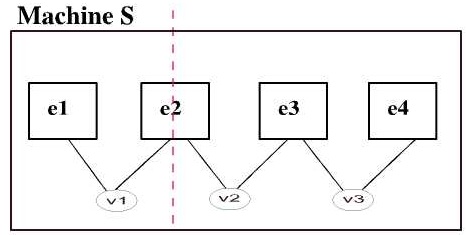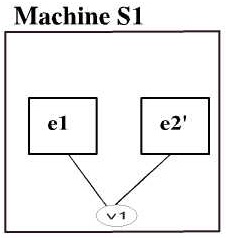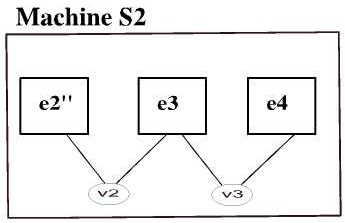Difference between pages "D45 Prover Enhancement" and "Parallel Composition using Event-B"
imported>Tommy |
imported>Mathieu |
||
| Line 1: | Line 1: | ||
| − | + | [[User:Renato]] at [[Southampton]] is in charge of the [[Parallel Composition using Event-B]]. | |
| − | |||
| − | |||
| − | |||
| − | + | Composition is the process by which it is possible to combine different sub-systems into a larger system. Known and studied in several areas, this has the advantage of reusability and combination of systems especially when it comes to distributed systems. While applying composition, properties must be maintained and proofs obligations need to be discharged in order for the final result to be considered valid. Our goal is to add this feature to the Rodin Platform (using Event-B notation) and study the concerns, properties, conditions, proof obligations, advantages and disadvantages when create/analysing system specifications. Since the composition maintains the monotonicity property of the systems, the sub-systems can be refined independently on a further stage, preserving composition properties. | |
| − | |||
| − | |||
| − | + | [[Image:share_event_machine.jpeg]] | |
| − | |||
| − | |||
| − | + | [[Image:share_event_mach_comp1.jpeg]] | |
| − | + | [[Image:share_event_machine_comp2.jpg]] | |
| − | |||
| − | |||
| − | |||
| − | |||
| − | + | A machine '''''S''''' with events '''''e1, e2, e3''''' and '''''e4''''' and variables '''''v1, v2''''' and '''''v3''''' can be decomposed using event (de)-composition of event ''e2'' (as can be seen above). This would result in the machine '''''S1''''' and '''''S2''''' that have a partial part of the event ''e2'': machine ''S1'' has the part related to the variable ''v1'' (''e2''') and machine ''S2'' has the part related to the machine ''v2'' (''e2''<nowiki>''</nowiki>). Also some other events are separated (''e1'' and ''v1'' only exist on machine ''S1'' and events ''e3'' and ''e4'' with variable ''v3'' only exist on the machine ''S2'') as can be seen above. | |
| − | |||
| − | |||
| − | |||
| − | |||
| − | |||
| − | + | The composition is based on proposals for parallel composition in Event-B in the following paper: [http://deploy-eprints.ecs.soton.ac.uk/51/]. | |
| − | |||
| − | |||
| − | |||
| − | |||
| − | |||
| − | + | A release of the composition plugin for Rodin 0.8.2 is available (email me:ras07r@ecs.soton.ac.uk). | |
| − | |||
| − | |||
| − | |||
| − | |||
| − | |||
| − | + | A release for Rodin 0.9.2.1 is now available from the Rodin Main Update Site. | |
| − | |||
| − | |||
| − | |||
| − | |||
| − | |||
| − | |||
| − | |||
| − | |||
| − | |||
| − | |||
| − | [[Category: | + | 1. To create a new composition file (bcp file), go to Toolbar (on top), New>>Other... Event-B>>Composition Machine. Then select the project (if not selected already) and filename (by default is cm.bcp). |
| + | |||
| + | 2. Bcp files are visible on Event-B perspective(from Rodin 0.9). For Rodin 0.8.2, go to Resource or Java perspective to edit the file. | ||
| + | |||
| + | 3. After editing the properties of the bcp file, you can generate a new bum file (machine), by using the green button on the toolbar (CM - symbol of machine) or by right clicling on the bcp file and choose the option :'Create Composed Machine'. You will have to introduce a name for the new machine and after that is just press 'OK'. | ||
| + | |||
| + | |||
| + | ''' | ||
| + | ==User Manual== | ||
| + | ''' | ||
| + | |||
| + | The Shared Event Composition Plugin is divided in 6 sections: | ||
| + | |||
| + | * '''Refines''' : allows to define an abstract machine of this composed machine. It is a valid machine that exists on the project. | ||
| + | * '''Includes''': to compose a model, it is necessary to define which sub-systems(machines) interact. The machines must be abstract (not refinements of other machines) and have to be valid. It is also possible to choose if the included machine invariant should be visible to the composed machine or not (for proof optimization). | ||
| + | * '''Sees''': allows to add contexts to the composed machine. The contexts seen by the ''included machines'' are visible to the composed machine. So it is only allowed to see contexts that are not already seen by the composed machine. | ||
| + | * '''Invariants''': allows the inclusion of invariant clauses to the composed file. The inclusion of more invariants (from the included machines) depends on the user’s choice on ''Includes''. The defined invariants on the composed machine are “joint” properties between the included machines (gluing invariants), so variables and contexts from all the included machines become part of the composed machine scope. | ||
| + | *'''Variant''': since the composed machine can be a refinement of an abstract model, there is the possibility of introducing new events. In order to avoid divergence, variants are necessary for the new events. | ||
| + | *'''Composes Events''': the interaction between systems only happens when the composed events are synchronised and ready to be executed. The systems can interact through shared parameters. It is possible to define the following properties for composes events: | ||
| + | ** Name: name of the composes event | ||
| + | ** Extended/Not Extended: in the composes machine refines an abstract machine and if there are events with the same name, the concrete event can extend the abstract one (from Rodin 0.9). | ||
| + | ** Convergence: event can be chosen from ''Ordinary'', ''Convergence'' or ''Anticipated''. | ||
| + | |||
| + | |||
| + | Still under '''Composes Events''', there are more properties that characterise a composed event: | ||
| + | * '''Refines''' : possibility to choose if the composes event it is a refinement of an abstract event | ||
| + | * '''Combines Event''': selection of the events that shall be composed. First the machine (out from the included machine list) is chosen and after, which event is supposed to be combined. It is possible to have only one combined event. | ||
| + | |||
| + | |||
| + | The '''Combination of Events''' can be expressed as: | ||
| + | * The parameters are listed in one single (composed) event. Parameters (from different events) with the same name will be merged (becoming only one parameter). This correspond to the shared event composition with message passing, where a parameter is passed from one event to other. | ||
| + | * The guards from the different combined events are merged using conjuction. So this composed event will be available if all the guards are true. | ||
| + | * the actions are also merged and executed in parallel. | ||
| + | |||
| + | Like mention above,a machine can be generated containing all the properties defined on the composed machine file. The generation of the new machine can be executed by using the green button on the toolbar (CM - symbol of machine) or by right clicling on the bcp file and choosing the option :''Create Composed Machine''. A name for the new machine have to be introduced (a name is suggested by default ) and by clicking 'OK' or 'Override', a new machine file is generated. | ||
| + | |||
| + | |||
| + | |||
| + | |||
| + | [[Category:Parallel composition plugin]] | ||
| + | [[Category:User documentation]] | ||
Revision as of 08:59, 4 March 2009
User:Renato at Southampton is in charge of the Parallel Composition using Event-B.
Composition is the process by which it is possible to combine different sub-systems into a larger system. Known and studied in several areas, this has the advantage of reusability and combination of systems especially when it comes to distributed systems. While applying composition, properties must be maintained and proofs obligations need to be discharged in order for the final result to be considered valid. Our goal is to add this feature to the Rodin Platform (using Event-B notation) and study the concerns, properties, conditions, proof obligations, advantages and disadvantages when create/analysing system specifications. Since the composition maintains the monotonicity property of the systems, the sub-systems can be refined independently on a further stage, preserving composition properties.
A machine S with events e1, e2, e3 and e4 and variables v1, v2 and v3 can be decomposed using event (de)-composition of event e2 (as can be seen above). This would result in the machine S1 and S2 that have a partial part of the event e2: machine S1 has the part related to the variable v1 (e2') and machine S2 has the part related to the machine v2 (e2''). Also some other events are separated (e1 and v1 only exist on machine S1 and events e3 and e4 with variable v3 only exist on the machine S2) as can be seen above.
The composition is based on proposals for parallel composition in Event-B in the following paper: [1].
A release of the composition plugin for Rodin 0.8.2 is available (email me:ras07r@ecs.soton.ac.uk).
A release for Rodin 0.9.2.1 is now available from the Rodin Main Update Site.
1. To create a new composition file (bcp file), go to Toolbar (on top), New>>Other... Event-B>>Composition Machine. Then select the project (if not selected already) and filename (by default is cm.bcp).
2. Bcp files are visible on Event-B perspective(from Rodin 0.9). For Rodin 0.8.2, go to Resource or Java perspective to edit the file.
3. After editing the properties of the bcp file, you can generate a new bum file (machine), by using the green button on the toolbar (CM - symbol of machine) or by right clicling on the bcp file and choose the option :'Create Composed Machine'. You will have to introduce a name for the new machine and after that is just press 'OK'.
User Manual
The Shared Event Composition Plugin is divided in 6 sections:
- Refines : allows to define an abstract machine of this composed machine. It is a valid machine that exists on the project.
- Includes: to compose a model, it is necessary to define which sub-systems(machines) interact. The machines must be abstract (not refinements of other machines) and have to be valid. It is also possible to choose if the included machine invariant should be visible to the composed machine or not (for proof optimization).
- Sees: allows to add contexts to the composed machine. The contexts seen by the included machines are visible to the composed machine. So it is only allowed to see contexts that are not already seen by the composed machine.
- Invariants: allows the inclusion of invariant clauses to the composed file. The inclusion of more invariants (from the included machines) depends on the user’s choice on Includes. The defined invariants on the composed machine are “joint” properties between the included machines (gluing invariants), so variables and contexts from all the included machines become part of the composed machine scope.
- Variant: since the composed machine can be a refinement of an abstract model, there is the possibility of introducing new events. In order to avoid divergence, variants are necessary for the new events.
- Composes Events: the interaction between systems only happens when the composed events are synchronised and ready to be executed. The systems can interact through shared parameters. It is possible to define the following properties for composes events:
- Name: name of the composes event
- Extended/Not Extended: in the composes machine refines an abstract machine and if there are events with the same name, the concrete event can extend the abstract one (from Rodin 0.9).
- Convergence: event can be chosen from Ordinary, Convergence or Anticipated.
Still under Composes Events, there are more properties that characterise a composed event:
- Refines : possibility to choose if the composes event it is a refinement of an abstract event
- Combines Event: selection of the events that shall be composed. First the machine (out from the included machine list) is chosen and after, which event is supposed to be combined. It is possible to have only one combined event.
The Combination of Events can be expressed as:
- The parameters are listed in one single (composed) event. Parameters (from different events) with the same name will be merged (becoming only one parameter). This correspond to the shared event composition with message passing, where a parameter is passed from one event to other.
- The guards from the different combined events are merged using conjuction. So this composed event will be available if all the guards are true.
- the actions are also merged and executed in parallel.
Like mention above,a machine can be generated containing all the properties defined on the composed machine file. The generation of the new machine can be executed by using the green button on the toolbar (CM - symbol of machine) or by right clicling on the bcp file and choosing the option :Create Composed Machine. A name for the new machine have to be introduced (a name is suggested by default ) and by clicking 'OK' or 'Override', a new machine file is generated.


